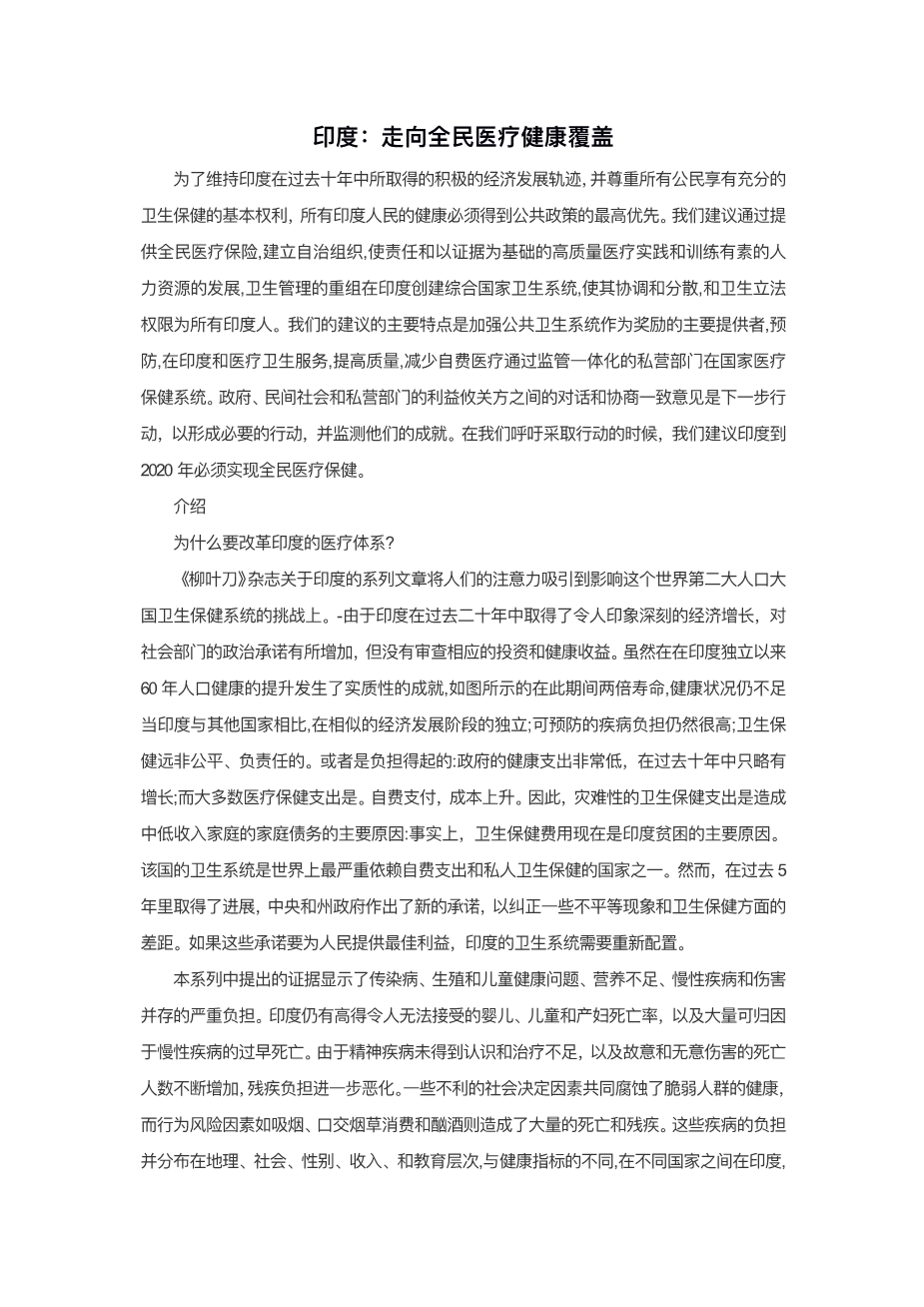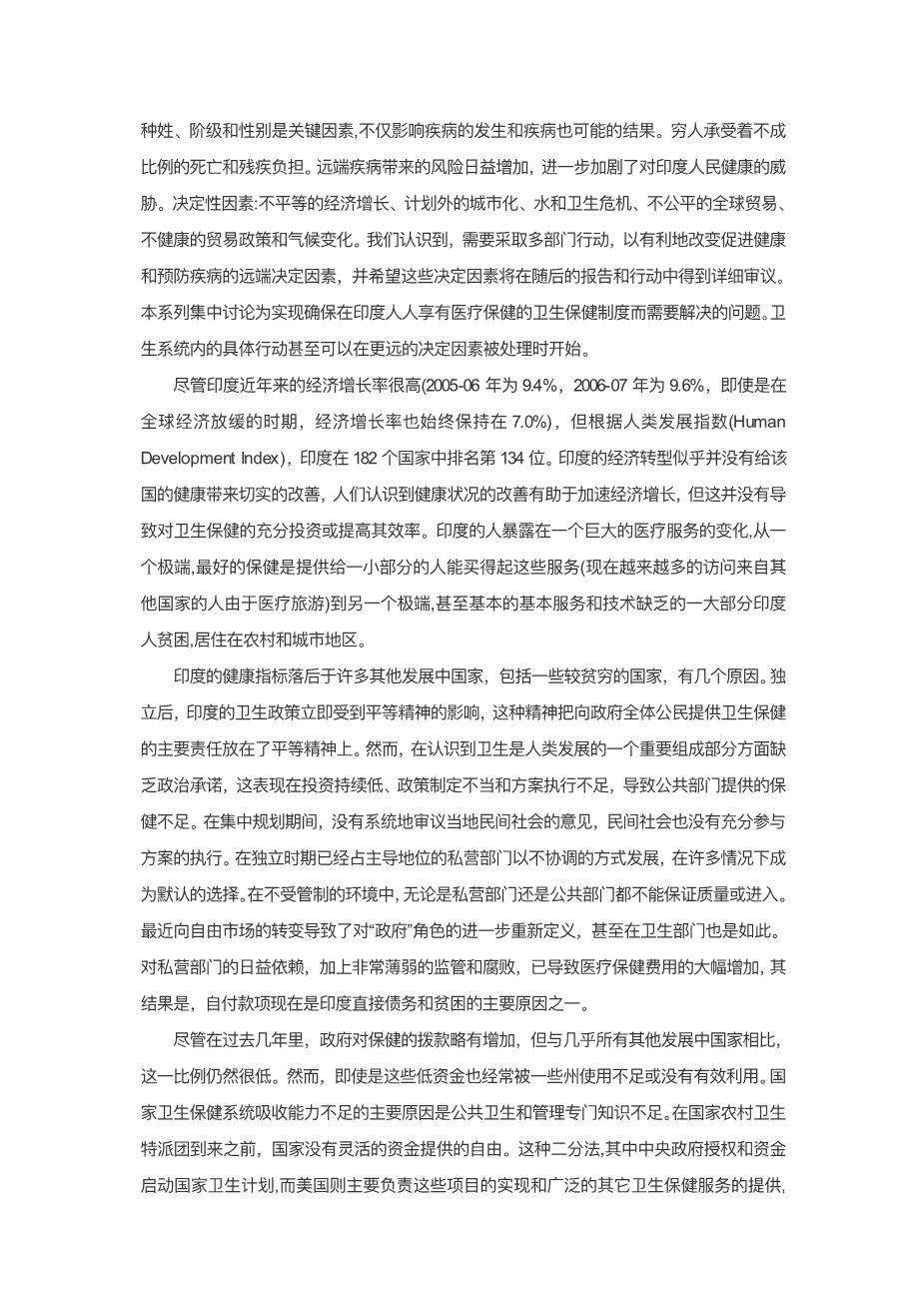To sustain the positive economic trajectory that India has had during the past decade, and to honour the fundamental right of all citizens to adequate health care, the health of all Indian people has to be given the highest priority in public policy. We propose the creation of the Integrated National Health System in India through provision of universal health insurance, establishment of autonomous organisations to enable accountable and evidence-based good-quality health-care practices and development of appropriately trained human resources, the restructuring of health governance to make it coordinated and decentralised, and legislation of health entitlement for all Indian people. The key characteristics of our proposal are to strengthen the public health system as the primary provider of promotive, preventive, and curative health services in India, to improve quality and reduce the out-of-pocket expenditure on health care through a well-regulated integration of the private sector within the national health-care system. Dialogue and consensus building among the stakeholders in the government, civil society, and private sector are the next steps to formalize the actions needed and to monitor their achievement. In our call to action, we propose that India must achieve health care for all by 2020.
Introduction
Why reform India's health-care system?
The Lancet Series about India draws attention to the challenges affecting the health-care system of the world's second most populous country. - With the impressive economic growth in India during the past two decades, the political commitment towards the social sector has increased but has not vet resulted in commensurate investments and health gains. Although substantial achievements have occurred in the improvement of population health in India in the 60 years since independence as shown by the doubling of life expectancy during this period, the health outcomes remain inadequate when India is compared with other countries that were at similar economic stages of development at the time of independence; preventable disease burden remains high; health care is far from equitable, accountable or affordable: Government healthy expenditure is very low and has risen only slightly during the past decade; and most spending on health care is paid out of pocket and is rising in cost. Thus, catastrophic health-care expenditures are a major cause of household debt for families on low and middle incomes: indeed costs of health care are now a leading cause of poverty in India. The country's health system ranks as one of the most heavily dependent on out-of-pocket expenditure and private health care in the world. However, progress has occurred in the past 5 years with new commitments by central and state governments to correct some of these inequities and gaps in health care. The health system in India needs to be reconfigured if these commitments are to provide optimum benefits to the people.
The evidence presented in-this Series shows the coexistence of substantial burdens of infectious diseases, reproductive and child health problems, nutritional deficiencies, chronic diseases, and injuries. India still has unacceptably high infant, child, and maternal mortality rates, and high numbers of premature deaths that are attributable to chronic diseases. The burdens of disability are further worsened by unrecognized and inadequately treated mental illness and the increasing toll of intentional and unintentional injuries. Several adverse social determinants together corrode the health of vulnerable populations, whereas behavioral risk factors like smoking, oral tobacco consumption and binge drinking of alcohol account for much death and disability. These burdens of ill health are inequitably distributed across geographical, social, gender, income, and educational strata, with substantial differences in health indicators between and within the different states in India, Caste, class, and gender are key factors that affect not just the occurrence of disease and ill health but also the likely outcomes. Individuals who are poor bear al disproportionate burden of death and disability. The threats to the health of the people of India are being further compounded by the rising risks posed by distal, determinants-i.e., unequal economic growth, unplanned urbanization, water and sanitation crises, inequitable global trade, unhealthy trade policies, and climate change. We do recognize that multispectral actions need to be initiated to favorably change the distal determinants to promote health and prevent disease, and hope that these will receive detailed deliberation in subsequent reports and action. This Series focuses on issues that need to be addressed to achieve a health-care system that ensures health care for all in India. Specific action within the health system can begin even while the more distal determinants are being addressed.
Although the Indian economy had high growth rates in recent years (9.4% in 2005-06 and 9.6% in 2006-07 with a consistent 7.0% growth rate even during the period of global economic slowdown), according to the Human Development Index India is ranked 134 among 182 countries. India's economic transformation does not seem to have produced tangible improvements in the health of the nation, and the recognition that improvement in health contributes to accelerated economic growth has not led to adequate investment in or improved the efficiency of health care. The people of India are exposed to a huge variation in health-care services, from one extreme in which the best possible care is provided to a small proportion of the population who can afford to pay for these services (now increasingly accessed by people from other countries as a result of medical tourism) to the other extreme in which even basic or essential services and technologies are lacking for a large proportion of the Indian people who are poor and liv
剩余内容已隐藏,支付完成后下载完整资料


英语译文共 8 页,剩余内容已隐藏,支付完成后下载完整资料
资料编号:[469270],资料为PDF文档或Word文档,PDF文档可免费转换为Word
以上是毕业论文外文翻译,课题毕业论文、任务书、文献综述、开题报告、程序设计、图纸设计等资料可联系客服协助查找。


